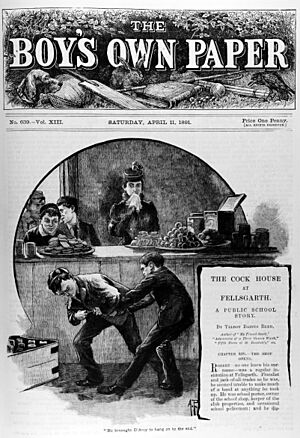Story paper facts for kids
A story paper was a type of magazine that had lots of pictures and exciting stories. They were made especially for children and teenagers. In Britain, they were often called "boys' weeklies." These papers were super popular before World War II.
One of the most famous British story papers was Boy's Own Paper. It was published for a very long time, from 1879 to 1967.
Contents
How Story Papers Began
The very first publication that was like a story paper was The Young Gentleman's Magazine, which came out in 1777. But the first one that really became popular was The Boys' and Girls' Penny Magazine, first printed in September 1832.
In 1866, a man named Charles Stephens started selling Boys of England on the streets of England for just one penny. This was the first "penny dreadful." These story papers were made very cheaply to keep their price low. Even though the original "penny dreadfuls" stopped being made around 1900, people still used the name for story papers for many years.
Fighting "Penny Dreadfuls"
Some people thought "penny dreadfuls" were bad for kids. So, in 1893, Halfpenny Marvel was created. Its title page said it was made "to counteract the pernicious influences of the Penny Dreadfuls," meaning to fight against their bad effects. A book about these weekly papers, also called "bloods" because of their exciting (and sometimes violent) stories, was written in 1948 by E. S. Turner. It was called Boys Will be Boys.
The Golden Age of Story Papers
The time between World War I and World War II is known as the "Golden Age" for story papers. During these years, more story papers were sold than ever before. Authors wrote many new stories, and there were lots of different types of magazines. The heroes in these stories were also very colorful and exciting. Sexton Blake, a very famous story paper hero, was most popular during this time.
The Dark Ages
When World War II started, it made things very difficult in Britain. Money and resources were needed for the war. Because of this, most story papers had to stop printing in 1939 or 1940. This period is sometimes called the Dark Ages for story papers.
Story Papers Change and Disappear
In the 1950s and 1960s, some story papers like The Rover became popular again for a short time. However, television was becoming more and more popular, and British children started watching TV instead of reading story papers.
Later, publishing companies started joining together. This led to the remaining story papers either stopping publication or changing into comic books in the 1970s. The Rover was the last one to survive, but it stopped printing in 1973.
What Was Inside Story Papers?
George Orwell, a famous writer, wrote an essay called Boys' Weeklies. In it, he talked about the main topics found in story papers during their "Golden Age." Orwell believed that Britain was the only country in Europe that made these kinds of story papers.
Stories for Everyone
Older story papers like The Gem and The Magnet often had stories about school life. These stories usually focused on a group of characters that any reader could easily relate to. Newer story papers, however, focused more on adventure and mystery. Many teenagers enjoyed reading these.
Important Messages
Orwell also noticed that most English story papers from that time seemed stuck in the 1910s. He felt they had a hidden message that taught kids to respect people from richer families. He thought that stories with ideas about fairness for everyone could be just as exciting if they were written in the story paper style.
Story papers were made for both boys and girls. Even though they were aimed at different groups, many kids read both the boys' and girls' papers.
List of Story Papers
UK Story Papers
- Adventure
- Aunt Judy's Magazine
- Boy's Best Story Paper
- Boys' Broadcast
- Boy's Champion
- The Boys' Friend
- Boys' Magazine
- Boys of England
- Boy's Own Paper
- The Boys' Herald
- The Boys' Realm
- Bullseye
- The Captain
- The Champion
- The Children's Friend
- Chums
- Dixon Hawke Library
- The Dreadnought
- The Empire
- The Gem
- Girl's Best Friend
- Girls' Crystal
- The Girl's Home
- Girl's Own Paper
- Girl's Reader
- The Girl's Realm
- Girl's Weekly
- The Greyfriars Herald
- Hotspur
- Halfpenny Marvel
- Jabberwock
- Joker
- Lion (boys' magazine)
- The Magnet
- The Marvel
- The Modern Boy
- Nelson Lee Library
- Our Girls
- Pals
- Peg's Paper
- The Penny Popular
- The Pilot
- Pluck
- Public School Magazine
- The Ranger
- Red Arrow
- The Rover
- School and Sport
- School Friend
- School Girls' Own
- Schooldays
- The Schoolgirl
- Schoolgirls' Weekly
- Scout
- The Sexton Blake Library
- The Skipper
- Startler
- The Thriller
- Tip Top
- The Triumph
- Union Jack
- The Vanguard
- The Wizard
- Young England magazine
- Young Folks
Irish Story Papers
- Our Boys (Ireland)
Australian Story Papers
- The Silver Jacket


